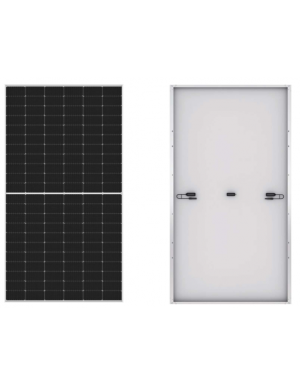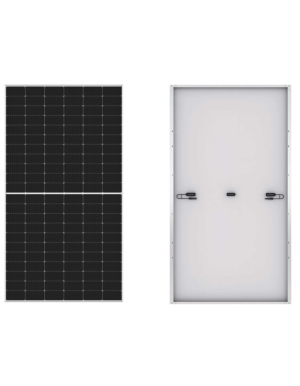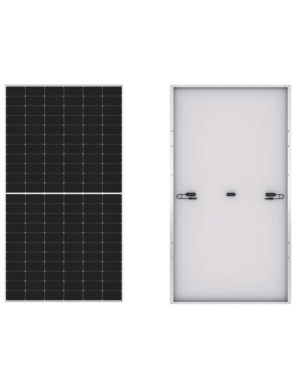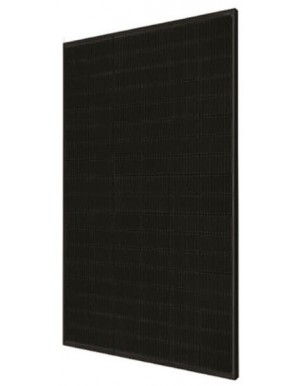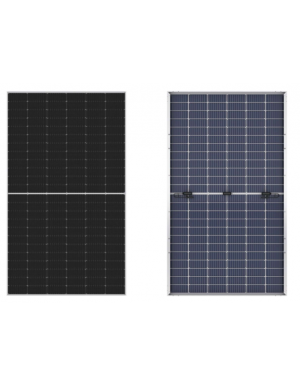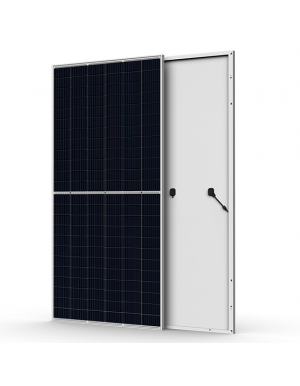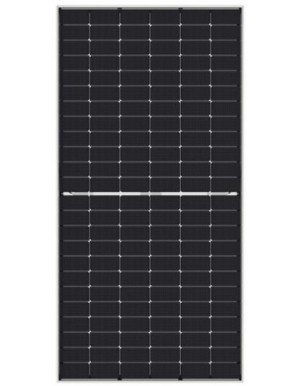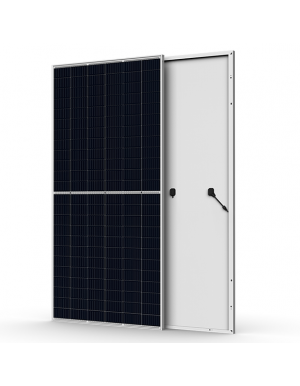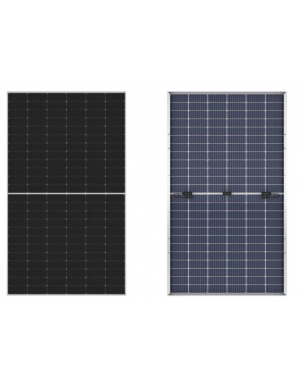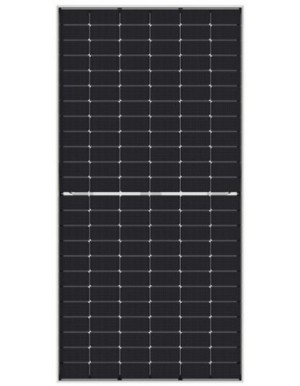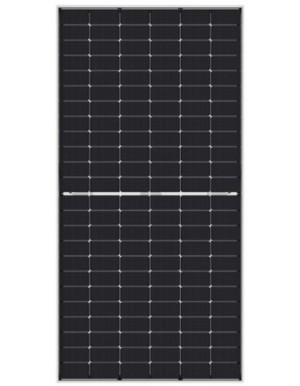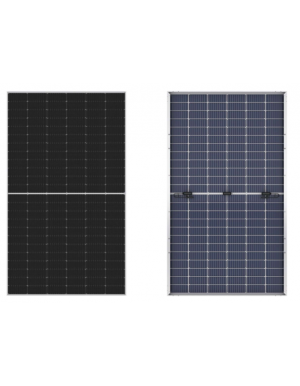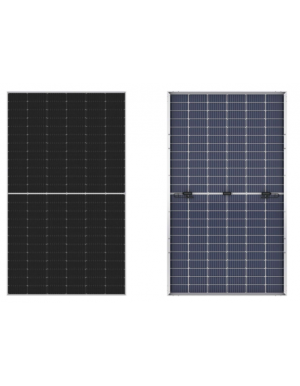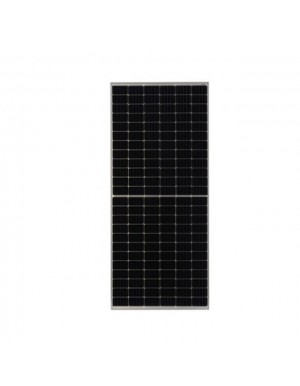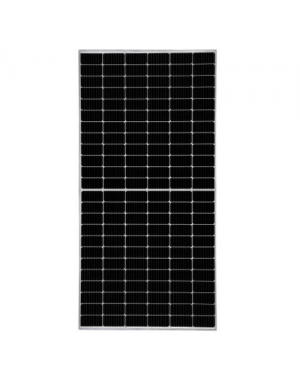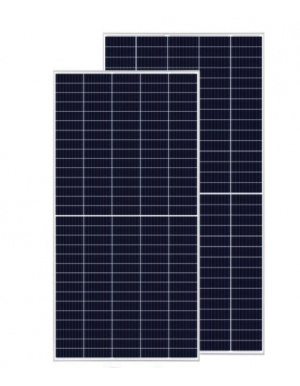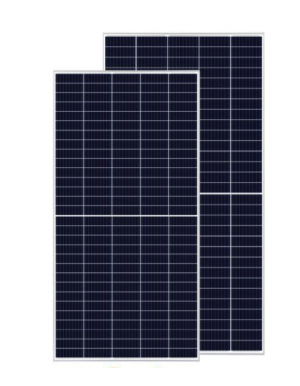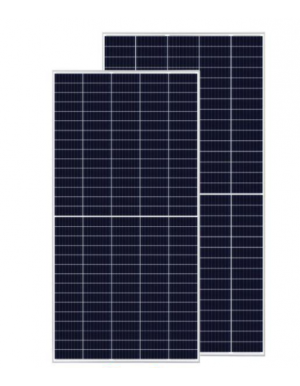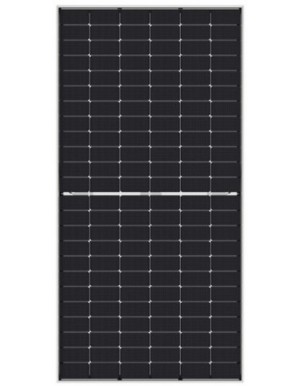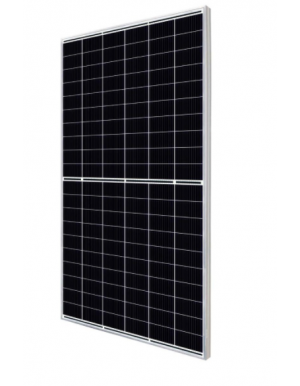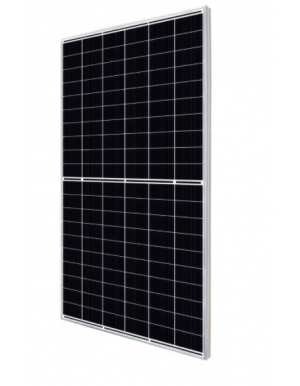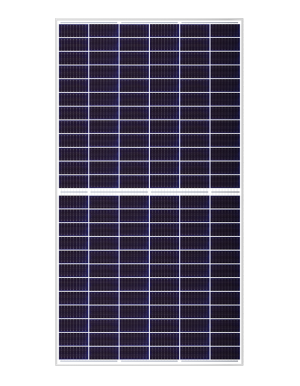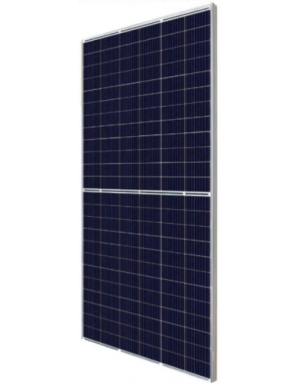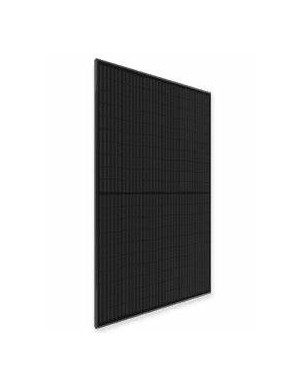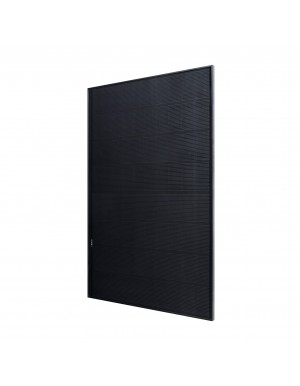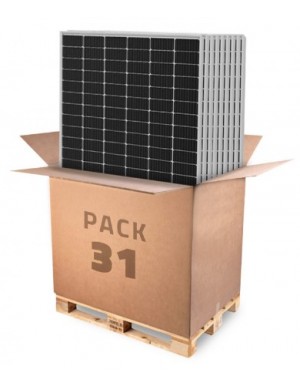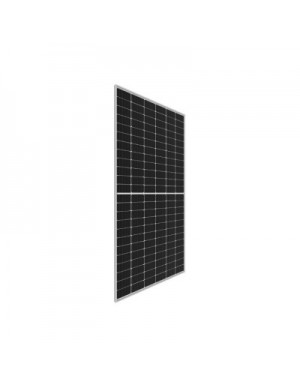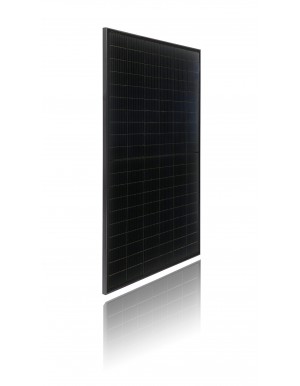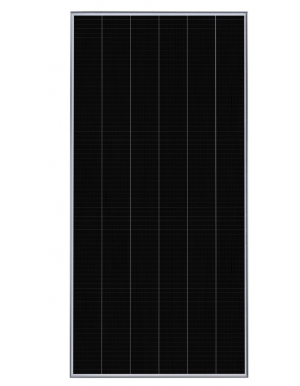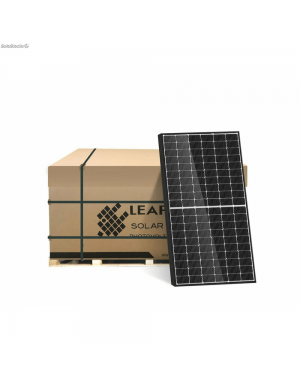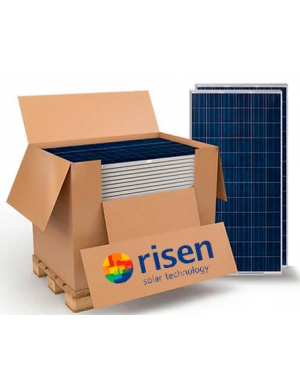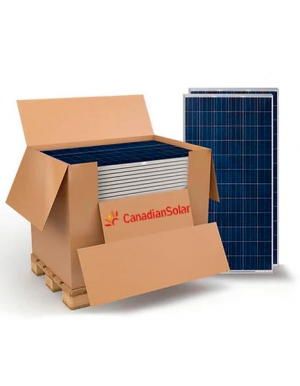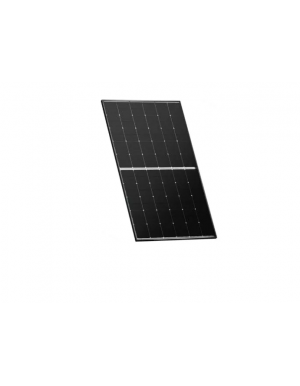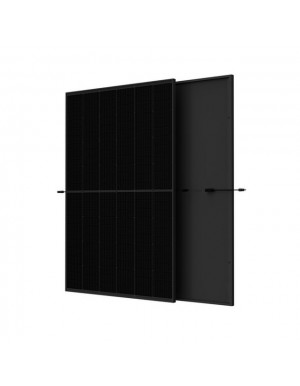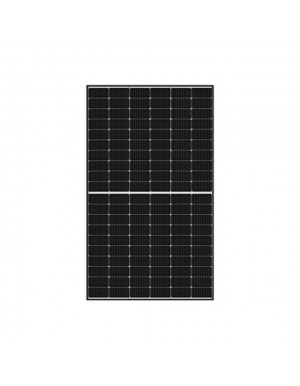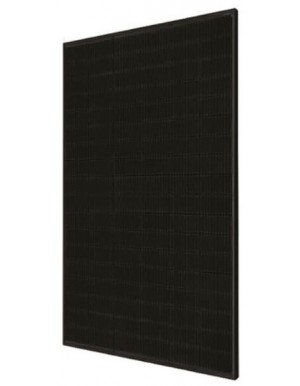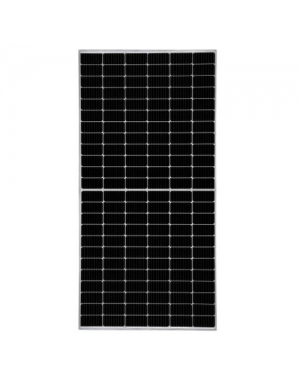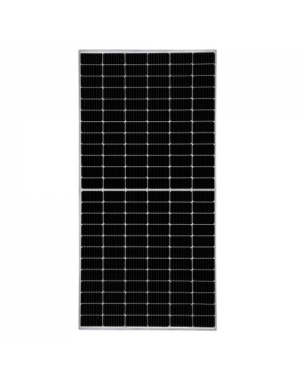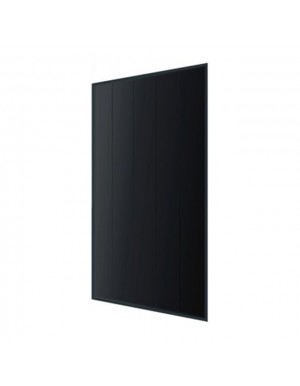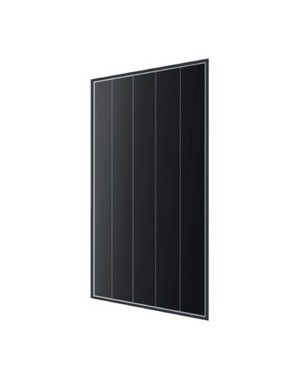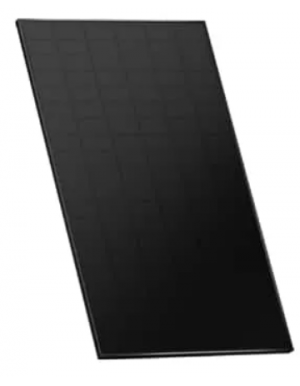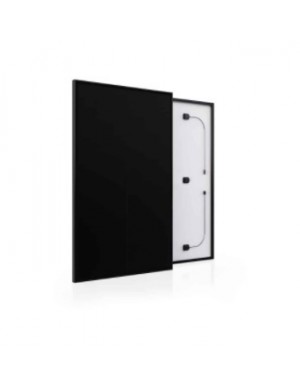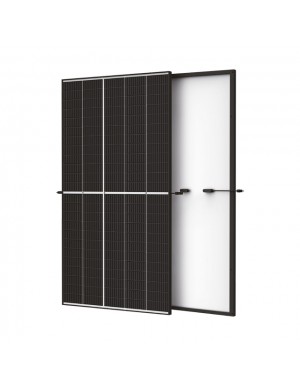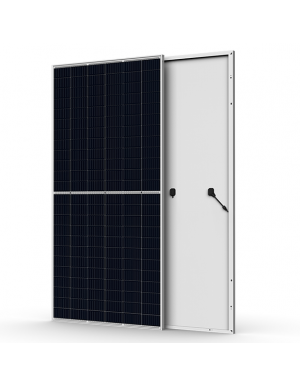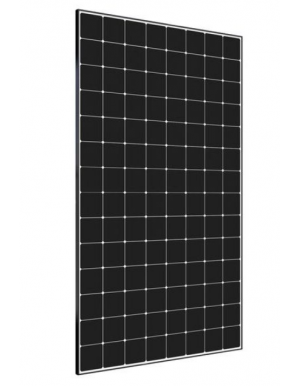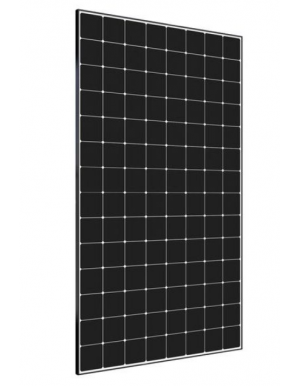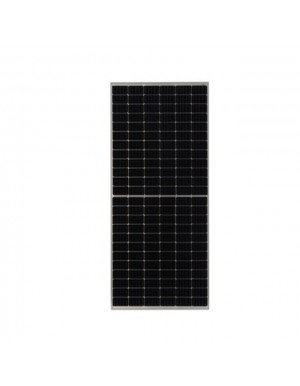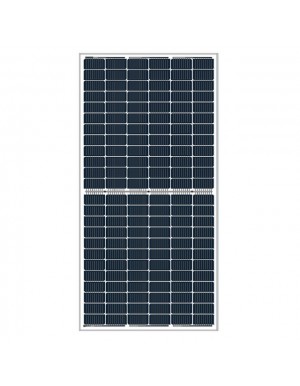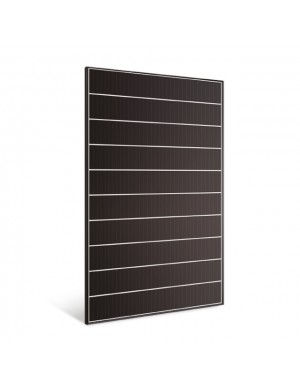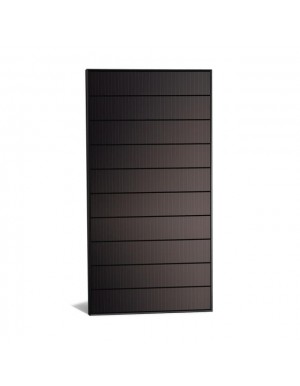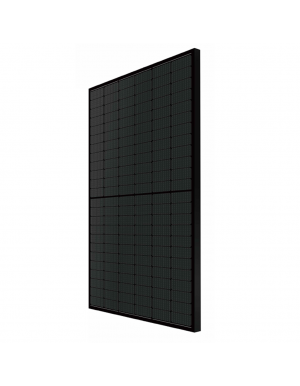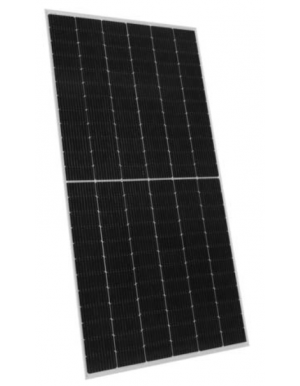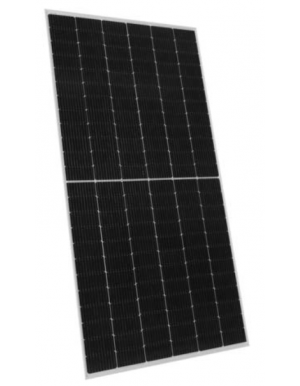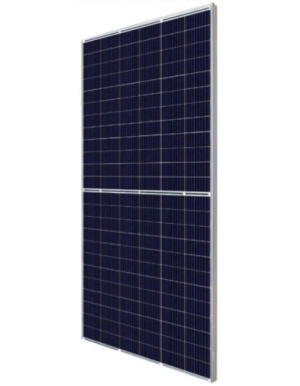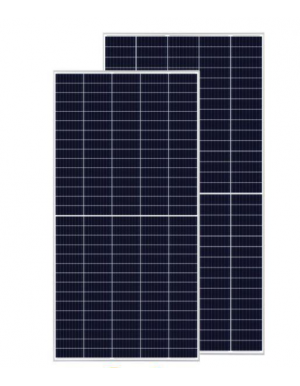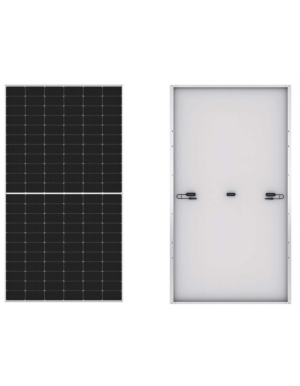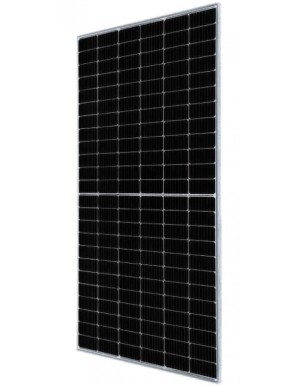Solar panel LONGI Hi-MO6 54HTH 440W Half Cut
Monocrystalline Longi solar panel of 440 Wp (108 split cells)
Monocrystalline photovoltaic module of PERC technology (Passive Enitter Rear Cell) of the Longi Solar brand of 440Wp with a high efficiency of up to 23%. This solar panel has a positive power tolerance of 0/+3% that ensures the production of energy throughout its life. Photovoltaic panel of high power and density of solar generation ideal for grid connected or isolated installations with space limitation. Connection of solar panels in series up to 1500V in open circuit
LONGI solar panels offer a 25-year product, manufacturing and material warranty and 25 years of production.
Solar panel LONGI Hi-MO6 54HTH 425W Half Cut
Monocrystalline Longi solar panel of 425 Wp (108 split cells)
Monocrystalline photovoltaic module of PERC technology (Passive Enitter Rear Cell) of the Longi Solar brand of 425Wp with a high efficiency of up to 22,5%. This solar panel has a positive power tolerance of 0/+3% that ensures the production of energy throughout its life. Photovoltaic panel of high power and density of solar generation ideal for grid connected or isolated installations with space limitation. Connection of solar panels in series up to 1500V in open circuit
LONGI solar panels offer a 15-year product, manufacturing and material warranty and 25 years of production.
Solar panel LONGI Hi-MO X6 72-cell 580W
Monocrystalline Longi solar panel of 580 Wp (144 split cells)
Monocrystalline photovoltaic module of PERC technology (Passive Enitter Rear Cell) of the Longi Solar brand of 580Wp with a high efficiency of up to 22,5%. This solar panel has a positive power tolerance of 0/+3% that ensures the production of energy throughout its life. Photovoltaic panel of high power and density of solar generation ideal for grid connected or isolated installations with space limitation. Connection of solar panels in series up to 1500V in open circuit
LONGI solar panels offer a 15-year product, manufacturing and material warranty and 25 years of production.
JA Solar 505Wp half-cut Silver
Deep Blue 3.0 series 66-cell half-cut 505W monocrystalline photovoltaic module with MC4 EVO2 connectors and long cables. 30 mm frame. Monocrystalline photovoltaic module Deep Blue technology 3.0 series of 66 half-cut 505W cells with MC4 EVO2 connectors and long cables. 30 mm frame
LONGI solar panel Hi-MO6 72-cell 575Wp Mono PERC Half-Cut framed in silver
Save your unit for June
The Commission has decided to initiate the procedure laid down in Article 108 (2) of the Treaty. New HPBC (Hybrid Passivated Back Contact) technology with better temperature coefficient and lower degradation. The Explorer version has a 15-year warranty.
Solar panel Trina 575Wp Half-Cut Silver Frame
The 570W Trina Solar Vertex Solar Panel is a 570W monocrystalline module with 132 cells from Trina Solar, one of the leading manufacturers in photovoltaic solutions and present in TIER 1. This Axitec solar panel has a 15 year product warranty and 25 year linear power warranty, with efficiencies ranging from 84.8% to 98%.
Solar panel Jinko Tiger NEO 565W Half Cut framed in silver
The panel Jinko solar Tiger Neo N-type 72HL4-(V) is a 565W monocrystalline module of 144 cells with MBB-HC technology, manufactured with the latest advances to make the most of solar radiation and ostensibly improve energy production. Efficiency of 22% thanks to the PASC technology.
Jinko Solar is the world leader and ranks first in the Tier 1 list.
The confidence of Jinko in its modules allow you to offer a product guarantee of 12 years, a linear power guarantee of 30 years with an annual degradation of 0,40 % for 30 years
Solar panel Trina 570Wp Half-Cut Silver Frame
The solar panel 570W Trina Solar Vertex is a 570W monocrystalline module and 132 cells of the brand Trina Solar, one of the leading manufacturers of photovoltaic solutions and present in Tier 1. These Axitec solar panels have a 15-year product guarantee and a 25-year linear power guarantee, with efficiencies ranging from 84.8% to 98%.
Solar panel LONGI Mono PERC 570Wp Half-Cut marco plateado Explorer 15Y
Out of stock
LONGi LR5 72HTH 570W photovoltaic module. Silver Frame. M10 half cell (182mm). Explorer version with 15 years product warranty. New HPBC (Hybrid Passivated Back Contact) technology with better temperature coefficient and less degradation.
Solar panel Jinko Tiger NEO 565W Cut Silver Frame
The Jinko Tiger Neo N-Type 565W Solar Panel 72HL4-V series is a 565W monocrystalline module from Jinko Solar, one of the leading manufacturers in the global photovoltaic industry. This Jinko module has a 15-year product warranty and a 30-year linear output warranty above 87.4%.
Optimize the performance of your installation. N-Type technology has been a major development in the photovoltaic sector thanks to the increased performance of photovoltaic modules. This type of cells have a back layer that helps to capture more solar irradiation and a sheet that makes the excess sunlight bounce back inside the cell and allows recovering the excess that the solar panels do not take advantage of.
Solar panel Jinko Tiger NEO 560W Bifacial SILVER Frame
See availability
We provide high efficiency solar modules. This is what makes it possible to obtain maximum solar performance at competitive prices.
The new generation of solar modules Jinko Solar assembled 144 single crystalline solar cells.
These monocrystalline solar panels Jinko Solar cells are made up of highly efficient integrated cells. This is what makes it possible to get maximum solar efficiency.
Solar panel LONGI Mono PERC 555Wp
Monocrystalline Longi solar panel of 555 Wp (144 split cells)
Monocrystalline photovoltaic module of PERC technology (Passive Enitter Rear Cell) of the Longi Solar brand of 555Wp with a high efficiency of up to 21,5%. This solar panel has a positive power tolerance of 0/+5W that ensures the production of energy throughout its life. Photovoltaic panel of high power and density of solar generation ideal for grid connected or isolated installations with space limitation. Connection of solar panels in series up to 1500V in open circuit
LONGI solar panels offer a 10-year product, manufacturing and material warranty and 25 years of production with a 4.10% increase in warranty compared to conventional solar panels
Solar panel LONGI Mono PERC 550Wp
Monocrystalline Longi solar panel of 550 Wp (144 split cells)
Monocrystalline photovoltaic module of PERC technology (Passive Enitter Rear Cell) of the Longi Solar brand of 550Wp with a high efficiency of up to 21,3%. This solar panel has a positive power tolerance of 0/+5W that ensures the production of energy throughout its life. Photovoltaic panel of high power and density of solar generation ideal for grid connected or isolated installations with space limitation. Connection of solar panels in series up to 1500V in open circuit
LONGI solar panels offer a 10-year product, manufacturing and material warranty and 25 years of production with a 4.10% increase in warranty compared to conventional solar panels
Solar panel JA Solar Mono PERC 570W Bifacial
Not in stock
Manufacture from materials of any heading JA Solar 570W of power, silver frame and 22.1% efficiency. With a positive power tolerance of 0/+5W. 12 years product warranty and linear power generation warranty for 30 years.
Assembled with bifacial MBB PERC cells and half-cell configuration, these double-glass modules have the ability to convert incident light at the rear and front side to electricity, providing higher power output, lower temperature coefficient and fewer shading losses, as well as improved mechanical load tolerance.
The solar panels JA Solar they belong to the group of brands selected as Tier 1 on the Bloomberg panel list.
Solar panel JA Solar Mono PERC 560W Bifacial
Monocrystalline solar panel JA Solar with 560W power, silver frame and an efficiency of 21.7%. With a positive power tolerance of 0/+5W. 12-year product warranty and 30-year linear power generation warranty.
Assembled with bifacial MBB PERC cells and half-cell configuration, these double glass modules have the ability to convert incident light on the back and front sides into electricity, providing higher power output, lower temperature coefficient and shading losses, as well as improved mechanical load tolerance.
JA Solar panels belong to the group of brands selected as Tier-1 in Bloomberg\'s list of solar panels.
Solar panel JA Solar 550Wp Bifacial
JA Solar Deep Blue series monocrystalline solar module JA SOLAR 550 W Bifacial Double Glass deep blue 3.0 marco plateado
Solar panel with 550Wp power output and high efficiency 21%. With positive power tolerance 0/+5W allows to reach maximum power of 550Wp. Warranty of 12 years of product and 25 years of production of linear type.
Anti-PID design with split cells by half (144 in total) smaller than traditional split-cell solar panels allows for high solar performance. JA Solar solar panels belong to the group of brands selected as Tier-1 being Trina one of the largest manufacturers of solar panels in the world.
Solar panel Risen Mono PERC 660Wp Titan
Risen monocrystalline solar panel 660 Wp - TITAN132-8-650M (132 split cells)
660Wp Risen monocrystalline photovoltaic module with PERC (Passive Emitter Rear Cell) technology with 21,2% module efficiency. This Risen solar panel has a positive power tolerance of 0/+5W ideal for grid-connected installations with limited space where space and power per square meter is a priority with operating voltages up to 1500V in series.
The TITAN132-8-660M 660Wp solar panel is a very high power panel manufactured by the prestigious Risen brand (Tier-1) with a 12 year product warranty and 25 years of production with linear degradation of the solar panel. Panel of great power and size that reduces the cost of mounting structures.
Solar panel Risen Mono PERC 650Wp Titan
Risen monocrystalline solar panel 650 Wp - TITAN132-8-650M (132 split cells)
650Wp Risen monocrystalline photovoltaic module with PERC (Passive Emitter Rear Cell) technology with 20.9% module efficiency. This Risen solar panel has a positive power tolerance of 0/+5W ideal for grid-connected installations with limited space where space and power per square meter is a priority with operating voltages up to 1500V in series.
The TITAN132-8-650M 650Wp solar panel is a very high power panel manufactured by the prestigious Risen brand (Tier-1) with a 12 year product warranty and 25 years of production with linear degradation of the solar panel. Panel of great power and size that reduces the cost of mounting structures.
Solar Panel Risen Mono PERC 440Wp
Monocrystalline photovoltaic module (Passive Emitter rear Cell) of 440Wp PERC 130 cells that stands out for its quality and high efficiency reaching 21.2% thanks to two factors, the Half Cell structure and the conversion capacity of the Mono PERC cells that minimise solar radiation losses. It reduces the thermal resistance and increases the output power between 5 and 10 Wp.
Photovoltaic solar panel with a silver frame and has a product warranty of 12 years and a power warranty of up to 25 years.
RISEN solar panels belong to the group of brands classified as Tier 1, the world\'s best manufacturers in the solar sector.
Solar panel Jinko Tiger NEO 565W Bifacial SILVER Frame
Monocrystalline solar panel Jinko Tiger with 565W power, silver frame and an efficiency of 21.87%. With a positive power tolerance of 0/+5W. 12-year product warranty and 30-year linear power generation warranty.
Assembled with bifacial SMBB PERC cells and half-cell configuration, these double glass modules have the ability to convert incident light on the back and front sides into electricity, providing higher power output, lower temperature coefficient and shading losses, as well as improved mechanical load tolerance.
Jinko panels belong to the group of brands selected as Tier-1 in Bloomberg\'s list of solar panels.
Solar panel Canadian Solar HiKu7 Mono PERC 665Wp
665 Wp Canadian Solar HiKu7 solar panel (132 split cells)
Monocrystalline photovoltaic module of PERC technology (Passive Enitter Rear Cell) of the prestigious Canadian Solar brand of 665Wp with 21.4% efficiency. This panel as all of the brand has a positive tolerance of power 0 / +10W ideal for grid connection facilities with space limitation where space and power per square meter with operating voltages of up to 1500V in series.
The 665Wp Hiku7 panel has a 12 year guarantee on product, manufacture and materials and 25 years of production with degradation of the solar panel in a linear way, which ensures the highest performance and reliability throughout the life of the photovoltaic installation. Dimensions 2384 mm x 1303 mm
Solar panel Canadian Solar HiKu7 Mono PERC 600Wp
600 Wp Canadian Solar HiKu7 solar panel (120 split cells)
Monocrystalline photovoltaic module of PERC technology (Passive Enitter Rear Cell) of the prestigious Canadian Solar brand of 600Wp with 20.8% efficiency. This panel as all of the brand has a positive tolerance of power 0 / +10W ideal for grid connection facilities with space limitation where space and power per square meter with operating voltages of up to 1500V in series.
The 600Wp Hiku7 panel has a 12 year guarantee on product, manufacture and materials and 25 years of production with degradation of the solar panel in a linear way, which ensures the highest performance and reliability throughout the life of the photovoltaic installation. Dimensions 2172 mm x 1303 mm
Solar panel Canadian Solar HiKu6 Mono PERC 405Wp
405 Wp Canadian Solar HiKu6 solar panel (108 split cells)
Polycrystalline photovoltaic module of PERC technology (Passive Emitter Rear Cell) of the prestigious Canadian Solar brand of 405Wp with 20.7% efficiency. This panel as all of the brand has a positive tolerance of power 0 / +10W ideal for grid connection facilities with space limitation where space and power per square meter with operating voltages of up to 1500V in series.
The 405Wp Hiku panel has a 12 year guarantee on product, manufacture and materials and 25 years of production with degradation of the solar panel in a linear way, which ensures the highest performance and reliability throughout the life of the photovoltaic installation. Dimensions 1722 mm x 1134 mm x 30 mm
Solar panel Canadian Solar HiKu6 Mono PERC 455Wp
455 Wp Canadian Solar HiKu6 solar panel (120 split cells)
Polycrystalline photovoltaic module of PERC technology (Passive Enitter Rear Cell) of the prestigious Canadian Solar brand of 455Wp with 21.1% efficiency. This panel as all of the brand has a positive tolerance of power 0 / +10W ideal for grid connection facilities with space limitation where space and power per square meter with operating voltages of up to 1500V in series.
The 455Wp Hiku6 panel has a 12 year guarantee on product, manufacture and materials and 25 years of production with degradation of the solar panel in a linear way, which ensures the highest performance and reliability throughout the life of the photovoltaic installation
Solar panel JA Solar Mono PERC 565W Bifacial SILVER Frame
Monocrystalline solar panel JA Solar with 565W power, silver frame and an efficiency of 21.9%. With a positive power tolerance of 0/+5W. 12-year product warranty and 30-year linear power generation warranty.
Assembled with bifacial MBB PERC cells and half-cell configuration, these double glass modules have the ability to convert incident light on the back and front sides into electricity, providing higher power output, lower temperature coefficient and shading losses, as well as improved mechanical load tolerance.
JA Solar panels belong to the group of brands selected as Tier-1 in Bloomberg\'s list of solar panels.
Solar panels Jinergy It's called a monkey
Solar panels Jinergy Monocrystalline Full Black of 400 Wp (108 split cells)
Single crystalline photovoltaic module with PERC technology of the brand Jinergy high efficiency 400 Wp (up to 21,25%). This solar panel has a positive power tolerance of 0/+5W which ensures excellent energy production throughout its useful life. High power and solar generation density panel, suitable for grid-connected or isolated installations with limited space. Solar panel ideal for 1000V installations in open circuit.
The solar panels Jinergy they offer a product guarantee of 12 years and 25 years of production with a 2.4% increase in guarantee compared to conventional solar panels.
1200 mm cable included for vertical mounting.
Solar panel REC Alpha Pure-R 410W Half-Cut Full Black
New REC ALPHA Solar Panels of great Efficiency and Durability. Unrivaled warranty.
REC Alpha is REC\'s latest family of solar panels, allowing you to get the most out of solar energy.
With 380 Wp of power from 60 cells, reaching 450 Wp in a 72-cell format, and an impressive 217 W/m², REC Alpha provides 20% more power than conventional panels, making it the panel of choice for system owners looking for the best.
Pallet (31 units) - Solar panel Jinergy Mono PERC 660Wp
Jinergy Monocrystalline solar panel of 660 Wp (132 split cells)
Monocrystalline photovoltaic module of PERC (Passive Enitter Rear Cell) technology of the Jinergy brand of 660Wp of high efficiency (up to 21.25%). This solar panel has a positive power tolerance of 0/+5W that ensures excellent energy production throughout its useful life. Panel of high power and density of solar generation, ideal for grid connection or isolated installations with limited space. Ideal solar panel for 1500V installations in open circuit.
Jinergy solar panels offer a 12-year product warranty and 25 years of production with a 4.1% increase warranty compared to conventional solar panels.
31 units pallet.
Solar panel Jinergy Mono PERC 450Wp
Jinergy Monocrystalline solar panel of 450 Wp (144 split cells)
Monocrystalline photovoltaic module of PERC (Passive Enitter Rear Cell) technology of the Jinergy brand of 450Wp of high efficiency (up to 20.7%). This solar panel has a positive power tolerance of 0/+5W that ensures excellent energy production throughout its useful life. Panel of high power and density of solar generation, ideal for grid connection or isolated installations with limited space. Ideal solar panel for 1500V installations in open circuit.
Jinergy solar panels offer a 12-year product warranty and 25 years of production with a 2.4% increase warranty compared to conventional solar panels.
1200 mm cable included for vertical mounting.
Solar FuturaSun FU440M SILK PRO Full Black
Monocrystalline panels are widely used especially for residential installations or where space is limited.
In fact, these panels are more efficient than polycrystalline modules because they have a higher power output at the same module size.
This does not mean that monocrystalline photovoltaic panels are better than polycrystalline ones, each model has its own function: we are always at your disposal to help you to choose among the various types of modules.
This solar panel is undoubtedly one of the most powerful on the market for residential and commercial installations with the guarantee of one of the first manufacturers of solar panels in the world. For any questions or doubts, please contact our technical team at info@tienda-solar.es.
Solar Panel SunPower PERFORMANCE 6 410W COM XS
- Silver Frame monocrystalline photovoltaic module with PERC technology with 410W output and 21.4% efficiency. This panel incorporates state-of-the-art technology from SunPower\'s PERFORMANCE 6 COM XS series, with overlapping tile cells and redundant connections between them, creating flexible paths for a continuous flow of electricity. It has a conductive adhesive that protects against ambient temperature changes.
It is an efficient and optimised solution that is well suited to the needs of commercial installations. In addition, its 25-year energy, product and service warranty makes it a very reliable long-term module for an installation.
SunPower solar panels belong to the Tier 1 brand group, the world\'s leading manufacturers in the solar industry.
Price on request
Pallet (31 Units) - Panel solar Leapton Mono 550W [S]
Due to its excellent performance, innovative design, and choice of crystals, it offers 21.4% more power than conventional modules while also lowering the working temperature of the panel and boosting efficiency.
15 years for the product and 25 years for the performance are covered by warranties.
Pallet (31 items) - Solar Panel Risen Mono PERC 455Wp
Split cell monocrystalline 455W solar panel. A modern panel that has a module efficiency of 20.6% and split cell technology\'s benefits for managing partial shadowing and enhancing temperature dissipation. A manufacturer with more than 15 years of expertise, Risen is known throughout the world for its quality to price ratio.
RISEN solar panels belong to the group of brands classified as Tier 1, the world\'s best manufacturers in the solar sector.
Pallet (31 items) - Solar panel Canadian HiKu7 600W
Due to its excellent performance, innovative design, and choice of crystals, it offers 21.4% more power than conventional modules while also lowering the working temperature of the panel and boosting efficiency.
12 years for the product and 25 years for the performance are covered by warranties.
The new Hiku7 module from Canadian Solar lowers the levelized cost of electricity by 3.5% and lowers the break-even cost of the system by 5.7%. The module achieves a 21.4% efficiency.
The Hiku7 module\'s cell spacing is smaller than or equivalent to 0.7mm, which makes it resistant to microcracking.
Solar panel Meyer Burger Glass 370W Bifacial
The Meyer Burger Glass 370 solar module , with a nominal power of 370W, with exclusive SmartWire technology plus HJT, Bifacial, glass-glass solar cells and made 100% in Germany . It has a 30-year product and power guarantee and stands out for its efficiency, reliability, robustness (due to its glass front and back) and the minimum guaranteed power of more than 93.2% at 25 years.
Solar Panel TRINA 410Wp Vertex S - Black
Monocristalline solar module TRINA 410Wp (144 cells) with 20,5% efficiency. Positive tolerance 0/+5W suitable for grid connected or off-grid applications of 3000V. Product warranty of 15 year and production warranty of 25 years.
Trina Vertex solar panels are made up of 144 cells, also called "triple-cut" because they are smaller than traditional cells. This type of solar panels are perfect for small residential or commercial solar installations since they optimize with less space the generation of electricity.
Solar panel LONGI Mono PERC 375Wp 60HPH - Black
Monocrystalline Longi solar panel of 375 Wp (120 split cells)
Monocrystalline photovoltaic module of PERC technology (Passive Enitter Rear Cell) of the Longi Solar brand of 375Wp with a high efficiency of up to 20,6%. This solar panel has a positive power tolerance of 0/+5W that ensures the production of energy throughout its life. Photovoltaic panel of high power and density of solar generation ideal for grid connected or isolated installations with space limitation. Connection of solar panels in series up to 1500V in open circuit
LONGI solar panels offer a 12-year product, manufacturing and material warranty and 25 years of production.
Solar panel JA Solar 550Wp mono PERC
JA Solar Deep Blue series monocrystalline solar module with PERC technology 550Wp (144 cells) - Tier 1 JA Solar monocrystalline
Solar panel with 550Wp power output and high efficiency 21%. With positive power tolerance 0/+5W allows to reach maximum power of 550Wp. Warranty of 12 years of product and 25 years of production of linear type.
Anti-PID design with split cells by half (144 in total) smaller than traditional split-cell solar panels allows for high solar performance. JA Solar solar panels belong to the group of brands selected as Tier-1 being Trina one of the largest manufacturers of solar panels in the world.
JA Solar 405Wp mono PERC - Black
JA Solar Deep Blue series monocrystalline solar module with PERC technology 405Wp (108 cells) - Tier 1 JA Solar monocrystalline
Solar panel with 405Wp power output and high efficiency 20,7%. With positive power tolerance 0/+5W allows to reach maximum power of 405Wp. Warranty of 12 years of product and 25 years of production of linear type.
Anti-PID design with split cells by half (108 in total) smaller than traditional split-cell solar panels allows for high solar performance. JA Solar solar panels belong to the group of brands selected as Tier-1 being Trina one of the largest manufacturers of solar panels in the world.
Solar panel JA Solar 395Wp mono PERC - Black
JA Solar Deep Blue series monocrystalline solar module with Deep-Blue technology 395Wp (108 cells) - Tier 1 JA Solar monocrystalline
Solar panel with 395Wp power output and high efficiency 21%. With positive power tolerance 0/+5W allows to reach maximum power of 395Wp. Warranty of 12 years of product and 25 years of production of linear type.
Anti-PID design with split cells by half (108 in total) smaller than traditional split-cell solar panels allows for high solar performance. JA Solar solar panels belong to the group of brands selected as Tier-1 being Trina one of the largest manufacturers of solar panels in the world.
Solar panel JA Solar 390Wp Half-Cut Black
JA Solar Deep Blue series monocrystalline solar module with PERC technology 385Wp (108 cells) - Tier 1 JA Solar monocrystalline
Solar panel with 385Wp power output and high efficiency 20,6%. With positive power tolerance 0/+5W allows to reach maximum power of 385Wp. Warranty of 12 years of product and 25 years of production of linear type.
Anti-PID design with split cells by half (120 in total) smaller than traditional split-cell solar panels allows for high solar performance. JA Solar solar panels belong to the group of brands selected as Tier-1 being Trina one of the largest manufacturers of solar panels in the world.
It's called Hyundai HG 430W Full Black
Stock in April
430W solar panel with an efficiency of 20.7%. It incorporates M6 PERC Shingled technology, which grants ultra-high efficiency with better performance in low irradiation.
This solar panel maximises sunlight as both LID (light-induced degradation) and PID (induced potential degradation) are eliminated to ensure higher actual performance over its lifetime. It has great strength thanks to tempered glass and reinforced frame, which withstand extreme weather conditions such as snow and wind. Several tests have also been passed, such as ammonia and salt fog.
Product and performance guarantee of 25 years. Linear guarantee from the second year, with an annual degradation of 0,55%, guaranteed 84,8% up to 25 years.
Solar Panel Hyundai HG 440W Black PERC
440W solar panel with an efficiency of 20.7%. It incorporates the M6 PERC Shingled technology, which provides ultra-high efficiency with better performance in low irradiance.
This panel maximises sunlight as both LID (Light Induced Degradation) and PID (Potential Induced Degradation) are eliminated to ensure higher real life performance. It is highly resistant thanks to the tempered glass and reinforced frame, which withstand extreme weather conditions such as snow and wind. It has also passed various tests such as ammonia and salt spray.
25-year product and performance warranty. Linear warranty from the second year, with an annual degradation of 0.55%, 84.8% is guaranteed up to 25 years.
Solar panel Meyer Burger Mono BLACK 380W
Monocrystalline BLACK 380W module that stands out for its quality, reliability, elegance and its high efficiency of 20.7%. It incorporates the exclusive SmartWire technology plus HJT solar cells, and is 100% manufactured in Germany.
It has a product and power warranty of 25 years and guarantees a minimum power of 92% after 25 years.
Solar panel SunPower PERFORMANCE 6 410W Black Frame
Monocrystalline photovoltaic module with black frame, with 410W of power and 20,9% efficiency. Panel with SunPower\'s state-of-the-art PERFORMANCE technology, with overlapping tile cells and redundant connections between them, creating flexible routes to achieve a continuous flow of electricity. It has a conductive adhesive that protects against ambient temperature changes.
It is an elegant, efficient and optimised solution that is well suited to the needs of commercial installations. It has a 25-year energy guarantee, which makes it a very reliable module.
SunPower solar panels belong to the group of brands classified as Tier 1, the world\'s best manufacturers.
Price on request
Solar panel Trina 500Wp mono PERC Black frame
Out of stock
It consists predominantly of hydrocarbons having carbon numbers predominantly in Trina Solar for use in the manufacture of products falling within headings 8521 to 8521
Manufacture from materials of any heading Trina Solar 500Wp high efficiency of 20.7%. With a positive power tolerance of 0/+5W, it is possible to achieve a maximum power of 500Wp. 15 years product warranty and 25 years linear type production.
Anti-PID design with split cells one third (150 in total) smaller than traditional split cell solar panels allow for high solar efficiency.
The solar panels Trina Solar trina is one of the three largest solar panel manufacturers in the world.
Solar panel Trina 500Wp mono PERC Silver frame
Out of stock
A single crystalline solar module of the VERTEX series of Trina Solar for use in the manufacture of products falling within headings 8521 to 8521
Manufacture from materials of any heading Trina Solar 500Wp high efficiency of 20.7%. With a positive power tolerance of 0/+5W, it is possible to achieve a maximum power of 500Wp. 15 years product warranty and 25 years linear type production.
Anti-PID design with split cells one third (150 in total) smaller than traditional split cell solar panels allow for high solar efficiency.
The solar panels Trina Solar trina is one of the three largest solar panel manufacturers in the world.
Solar panel SunPower MAXEON 6 460W
Monocrystalline photovoltaic module with Maxeon 6 cell technology with 460W of power and 21.6% efficiency. This panel incorporates state-of-the-art technology from SunPower\'s MAXEON series, with sustainably manufactured cells, high durability and resistance against external agents.
It is a reliable, efficient and durable solution that is well suited to today\'s residential needs. It is the solar panel with the best price/energy output ratio on the market. In addition, its unique 40-year energy, product and service warranty makes it a very reliable long-term module for a photovoltaic installation.
SunPower solar panels belong to the group of brands classified as Tier 1, the world\'s best manufacturers in the solar sector.
Price on request
Panel solar SunPower MAXEON 6 425W Black Frame
Monocrystalline photovoltaic module with Maxeon 6 cell technology with 425W of power and 22% efficiency. This panel incorporates state-of-the-art technology from SunPower\'s MAXEON series, with sustainably manufactured cells, high durability and resistance against external agents.
It is a reliable, efficient and durable solution that is well suited to today\'s residential needs. It is the solar panel with the best price/energy output ratio on the market. In addition, its unique 40-year energy, product and service warranty makes it a very reliable long-term module for a photovoltaic installation.
SunPower solar panels belong to the group of brands classified as Tier 1, the world\'s best manufacturers in the solar sector.
Price on request
Solar panel JA Solar Mono PERC 540W Bifacial SILVER Frame
Monocrystalline solar panel JA Solar with 540W power, silver frame and an efficiency of 20.9%. With a positive power tolerance of 0/+5W, it can reach a maximum power of 578W. 12-year product warranty and 30-year linear power generation warranty.
Assembled with bifacial 11BB PERCIUM cells and half-cell configuration, these double glass modules have the ability to convert incident light on the back and front sides into electricity, providing higher power output, lower temperature coefficient and shading losses, as well as improved mechanical load tolerance.
JA Solar panels belong to the group of brands selected as Tier-1 in Bloomberg\'s list of solar panels.
Solar panel LONGI 450W HiMO4 72HBD Bifacial
450W solar panel and 20.7% efficiency. The bifacial technology allows the collection of additional energy in the rear part (up to 25%).
This panel has a better use of energy with an excellent performance of low irradiation and temperature coefficient. Annual power reduction of 0.45%. The optimised electrical design and lower operating current reduce the risk of hot spots. It is a durable solution as quality materials have been used in the manufacturing process.
12 years warranty on materials and processing and 30 years warranty on the extra linear power output.
Solar panel Hyundai VG 415W
415W solar panel with an efficiency of 21.2%. It incorporates the M6 PERC Shingled technology, which provides ultra-high efficiency with better performance in low irradiance.
This panel maximises sunlight as both LID (Light Induced Degradation) and PID (Potential Induced Degradation) are eliminated to ensure higher real life performance. It is highly resistant thanks to the tempered glass and reinforced frame, which withstand extreme weather conditions such as snow and wind. It has also passed various tests such as ammonia and salt spray.
25-year product and performance warranty. Linear warranty from the second year, with an annual degradation of 0.55%, 84.8% is guaranteed up to 25 years.
Solar panel Hyundai VG 400W - Full Black
400 W full black solar panel with 20.4% efficiency. This panel incorporates M6 PERC Shingled technology, giving ultra high efficiency with improved low irradiance performance.
This panel maximises sunlight as both LID (Light Induced Degradation) and PID (Potential Induced Degradation) are eliminated to ensure higher real life performance. It is highly resistant thanks to the tempered glass and reinforced frame, which withstand extreme weather conditions such as snow and wind. It has also passed various tests such as ammonia and salt spray.
25-year product and performance warranty. Linear warranty from the second year, with an annual degradation of 0.55%, 84.8% is guaranteed up to 25 years.
Solar panel HUASUN HS-B120DSN 390W Bifacial Transparent- Black frame
390 W transparent black frame bifacial solar panel with 22% efficiency. This panel incorporates the use of the advanced 12BB HJT Cell with half-cut design to ensure higher power output, high production capacity and low degradation.
It is a reliable, efficient and durable solution as quality materials are used in production. Production energy losses in the first year are 1% and later 0.37% per year, resulting in a fantastic yield. Resistant to snow loads and strong winds and with better protection against bad weather.
15 year product warranty and 30 year power warranty.
Solar panel Jinko Tiger Pro 545W
Jinko Solar 545Wp (72 split cells) monocrystalline photovoltaic module / panel with PERC (Passive Emiter Rear Contact) technology with 21.30% efficiency. Positive tolerance 0/+3% for solar photovoltaic installations connected to the grid or isolated up to 1500V of the system. 10-year product warranty and 25 years of production.
The Jinko solar panels of the monocrystalline Tiger Pro series in their different power variants (up to 550Wp) are composed of 72 split solar cells (virtually 144 cells) with 5 bus bar technology distributed in a grid of 6 columns and 24 rows. This series of Jinko has as the Cheetah series PERC technology which gives it superior efficiencies making its solar panels of high performance and split cells.
Solar panel Canadian Solar HiKu Mono PERC 455Wp
455 Wp Canadian Solar HiKu5 solar panel (144 split cells)
Polycrystalline photovoltaic module of PERC technology (Passive Enitter Rear Cell) of the prestigious Canadian Solar brand of 455Wp with 20.6% efficiency. This panel as all of the brand has a positive tolerance of power 0 / +10W ideal for grid connection facilities with space limitation where space and power per square meter with operating voltages of up to 1500V in series.
The 455Wp Hiku panel has a 12 year guarantee on product, manufacture and materials and 25 years of production with degradation of the solar panel in a linear way, which ensures the highest performance and reliability throughout the life of the photovoltaic installation
Solar panel Risen Mono PERC 545Wp Titan
Risen monocrystalline solar panel 545 Wp - TITAN110-8-545M (110 split cells)
545Wp Risen monocrystalline photovoltaic module with PERC (Passive Emitter Rear Cell) technology with 20.9% module efficiency. This Risen solar panel has a positive power tolerance of 0/+5W ideal for grid-connected installations with limited space where space and power per square meter is a priority with operating voltages up to 1500V in series.
The TITAN110-8-545M 545Wp solar panel is a very high power panel manufactured by the prestigious Risen brand (Tier-1) with a 12 year product warranty and 25 years of production with linear degradation of the solar panel. Panel of great power and size that reduces the cost of mounting structures.
Solar panel LONGI Mono PERC 545Wp PERC
Monocrystalline Longi solar panel of 545 Wp (144 split cells)
Monocrystalline photovoltaic module of PERC technology (Passive Emitter Rear Cell) of the Longi Solar brand of 545Wp with a high efficiency of up to 21,4%. This solar panel has a positive power tolerance of 0/+5W that ensures the production of energy throughout its life. Photovoltaic panel of high power and density of solar generation ideal for grid connected or isolated installations with space limitation. Connection of solar panels in series up to 1500V in open circuit
LONGI solar panels offer a 10-year product, manufacturing and material warranty and 25 years of production.
Solar panel JA Solar 460Wp mono PERC
JA Solar monocrystalline solar module with PERC technology 460Wp (144 cells) - Tier 1 JA Solar monocrystalline
Solar panel with 460Wp power output and high efficiency 20,7%. With positive power tolerance 0/+5W allows to reach maximum power of 465Wp. Warranty of 12 years of product and 25 years of production of linear type.
Anti-PID design with split cells at one third (144 in total) smaller than traditional split-cell solar panels allows for high solar performance. JA Solar solar panels belong to the group of brands selected as Tier-1 being Trina one of the largest manufacturers of solar panels in the world.
More of Solar panels
Solar panels contain several solar cells connected in series or parallel. These are protected by a hardened glass pane as the uppermost panel layer as well as by a foil underneath. The sun's rays penetrate the two transparent layers and then hit the solar cells, which convert the UV radiation into electricity. On the reverse side, the cells are protected by a film or another glass panel, depending on the module type.
Simply install your solar system on your roof, terrace or greenhouse yourself and feed the electricity generated by your solar modules directly into your house. TIENDA SOLAR offers a variety of premium quality proven photovoltaic solar panels to suit every budget and achieve high-performance levels. They are also resistant to external influences and therefore very durable. For these reasons, our photovoltaic systems are particularly suitable for use in private homes and small businesses. The installation of solar systems is no longer the exclusive domain of specialist tradesmen: Now anyone can easily install them themselves. We offer solar panels at very competitive prices to make green energy accessible to everyone.
The right solar module for every need
Due to the abundance of offers, the choice of the right solar panel is difficult. In order to keep the overview and to find the suitable solar panels, the following questions have to be considered:
-
What performance should a solar panel achieve?
The performance that a solar panel should achieve depends on several factors, such as the type of panel, the geographical location, the orientation and tilt of the panel, the quality of the components, and the environmental conditions. Here are some key aspects to consider in order to understand what the performance of a solar panel can be:
- Solar panel efficiency: The efficiency of a solar panel refers to the amount of solar energy it can convert into electricity. More efficient solar panels can convert more sunlight into electricity, which means they require less space to generate a certain amount of energy. Currently, typical commercial solar panels have efficiencies ranging from 15% to 22%, although some high-end panels can reach efficiencies in excess of 24%. The efficiency of a solar panel is usually stipulated on the panel's data sheet. However, the efficiency described in the data sheet of the solar panel is considered in the so-called STC (Standard Test Coniditions). The electrical parameters of the solar panel (Isc / Voc and efficiency) are given at 25ºC cell temperature of the solar panel, 1000W/m2 irradiance perpendicular to the solar panel and a wind speed of 1m/s. The different factors described will be modified in the actual application of the panel. This is why the efficiency of the solar panel varies according to the actual conditions to which it is subjected.
- Geographical location: The location of the solar panels plays an important role in their performance. Regions with greater sun exposure and less cloud cover generally have higher solar output. Locations closer to the equator tend to have higher solar potential.Geographic location is a relevant factor that determines the incident irradiance on the solar panel which may or may not be higher than the 1000W/m2 established in the STC (Standard Test Conditions) mentioned above.
- Orientation and tilt: The orientation of the solar panels towards the sun and their tilt are crucial factors. In the northern hemisphere, panels should face south to capture the most sunlight throughout the day while in the southern hemisphere they should face north. The ideal tilt depends on the latitude of the location; in general, an approximate angle is equal to latitude minus 10-15 degrees. The tilt of the solar panels has a direct impact on the incident irradiance in the perpendicular plane of the panels and consequently on the electrical power generation capacity.
- Component quality: The quality of solar panels and associated components, such as EVA, Tedlar or internal conductors, will affect long-term performance. Poor quality panels may degrade faster and not reach their energy production potential. LID (Light Induced Degradation) and PID (Power Induced Degradation) degradation are usually the result of poor design or low quality solar panel materials.
- Environmental conditions: Climatic and environmental conditions, such as temperature, humidity and pollution, can affect the performance of solar panels. Most panels have an annual degradation of about 0.5% to 1%, which means that their performance will decrease slightly over time. If you look at the data sheet of any solar panel you can see several performance coefficients. These are the panel temperature coefficient and irradiance coefficient. The first one establishes the relationship of the given power of the solar panel with the cell temperature (-W/ºC). This coefficient establishes a negative relationship which means that the hotter it is, the less the solar panel produces. The irradiance coefficient indicates how the intensity given by the solar panel varies with respect to the incident irradiance. This coefficient indicates that the higher the irradiance, the higher the current and power supplied by the panel.
In general, a good goal for solar panel performance is to achieve an annual electrical energy production that is commensurate with the owner's expectations and needs. This can vary widely depending on the location and the intended use of the power generated. To get a more accurate estimate, it is advisable to consult with one of our solar experts or use our online tool to calculate the solar potential at a specific location.
-
How long can a solar panel last?
The lifetime of a solar panel depends on several factors, including the quality of the materials used in its manufacture, the design of the installation, local climatic conditions and proper maintenance. In general, solar panels are designed to have a useful life of at least 25 to 30 years. However, many solar panels continue to operate effectively even after this period. Some aspects that can influence the lifetime of a solar panel include:
- Quality of materials: higher quality solar panels tend to have a longer service life. The materials used in the manufacture of the solar cells and in the encapsulation of the panels can determine their resistance to degradation over time.
- Manufacturer warranties: Many solar panel manufacturers offer performance and durability warranties that can be useful in evaluating the quality of the product. Some performance guarantees promise that the panels will continue to generate a certain amount of electricity for a specified period, such as 80% of their rated capacity after 25 years, for example.
- Climatic conditions: Solar panels are designed to withstand various weather conditions, but constant exposure to extremely hot, cold or humid climates could accelerate the degradation process.
- Maintenance: Proper maintenance, such as regular cleaning of solar panels to remove dust and dirt buildup, can help extend their life.
- Technology and design: The evolution of solar technology can also influence the lifetime of panels. Advances in the design and construction of solar panels can improve their strength and efficiency over time.
In short, if properly installed and maintained, solar panels can last at least 25 to 30 years, and may continue to operate even beyond that period. When planning a solar power installation, it is advisable to consider the quality of the panels and the warranties offered by the manufacturers to make informed decisions about your investment.
-
What happens to solar panels when it rains?
When it rains, solar panels are not significantly affected and, in fact, rain can have some positive effects on their performance. Here are some things that happen when it rains on solar panels:
- Cleaning: Rain can help clean solar panels by removing dust, dirt and other deposits that might build up on their surface over time. This can temporarily improve the efficiency of the panels by allowing sunlight to reach the photovoltaic cells more effectively.
- Cooling: Solar panels can become hot due to constant solar radiation. Rain can help cool them, which in turn can improve their performance. High temperatures can reduce the efficiency of PV cells, so the cooling provided by rain can be beneficial in this regard.
- Energy production: Although the intensity of sunlight decreases during rain due to clouds and light scattering, solar panels will still generate electricity to some extent. Rain does not completely block sunlight, so power production does not stop completely. - Drainage: Solar panels are designed to be water resistant and generally have integrated drainage systems to ensure that rainwater does not accumulate on their surface. This avoids problems such as water accumulation that could affect the efficiency of the panels or even damage them over time.
In short, solar panels are designed to operate in a variety of weather conditions, including rain. While energy production may decrease slightly during periods of rain due to reduced sunlight intensity, in general, solar panels remain effective and continue to generate power in these conditions.
-
What should the photovoltaic system look like?
A solar system, also known as a solar PV system, is designed to capture the sun's energy and convert it into usable electricity. Here is a description of what a basic solar system should look like. This system is the main elements that solar panels need to channel and adapt the energy generated to the needs of domestic or industrial consumption.
- - Solar panels: The heart of the solar system are the solar panels, also called photovoltaic modules or solar panels. These panels are composed of solar cells that convert sunlight into electricity. The solar panels are installed on a structure that elevates them and orients them towards the sun to maximize the energy yield. They can be of different types, such as monocrystalline, polycrystalline or thin film, each with its own advantages and disadvantages in terms of efficiency and cost.
- - Solar Inverter: The electrical power generated by solar panels is in the form of direct current (DC). However, most domestic and industrial electrical devices and systems use alternating current (AC). Therefore, an inverter is needed to convert the direct current into alternating current, making it compatible for use in homes and buildings.
- - Mounting structure: The solar panels are mounted on a structure (aluminum, steel or concrete) that raises them above the ground or roof, allowing their correct orientation towards the sun. The inclination and orientation of the structure must be adjusted according to the geographical location to maximize solar exposure. We can find different types of mounting systems; fixed coplanar, fixed for flat roofs or single-axis solar trackers (the most common).
- - Wiring system: Solar panels, inverter and other system components must be connected by electrical cables. A proper wiring system ensures that the power generated is transmitted efficiently and safely. It is important to use solar cables that are double insulated and to use the correct cable cross-section to minimize losses and voltage drops. -
- - Bi-directional meter: In some locations, a bi-directional meter is installed that records both the energy consumed from the grid and the energy generated by the solar system. This allows you to track the amount of energy flowing in both directions.
- - Storage (optional): If you want to store the power generated for use at night or during times of low solar generation, you can consider incorporating solar storage batteries into your solar system. The batteries store excess energy for later use. Depending on your needs and circumstances, you can choose lithium, lead-acid or stationary batteries.
- - Monitoring and control: To ensure efficient operation and track the performance of the solar system, it is useful to have monitoring and control systems. These systems allow you to check energy production in real time and detect any potential problems.
It is important to design a solar system tailored to your energy needs and the characteristics of your location. The help of a professional solar installer can be invaluable in ensuring proper design and installation.
-
Should a system be installed on or integrated into the roof?
The decision to install a solar system on or on the roof depends on several factors, such as roof structure, orientation, available space, and personal preference. Here are some considerations to help you make an informed decision:
On-roof installation (roof-mounted):
- Available space: If you have enough space on your roof and the structure is adequate, this option may be suitable because it takes advantage of space that might otherwise be unused.
- Orientation and Tilt: You can adjust the orientation and tilt of the panels to maximize sunlight capture. This is beneficial for optimizing energy generation.
- Avoid Obstruction: If the surrounding area has no obstructions such as tall trees or buildings, the rooftop installation could offer unobstructed solar exposure.
- Increased Energy Efficiency: By placing the panels on the roof, they also provide shade and thermal insulation to the building, which can contribute to greater overall energy efficiency.
- Aesthetics: Some people prefer rooftop installation because the solar panels are less visible from the ground, which can be important for maintaining the aesthetics of the building.
In-roof installation (roof integration):
- Integrated Aesthetics: In this approach, the solar panels are integrated directly into the roof structure, which can give a cleaner and more aesthetically pleasing appearance compared to rooftop installation.
- Less Wind: Integrated panels may have less exposure to wind, which could be an advantage in areas prone to high winds.
- Additional Protection: By being integrated into the roof, the panels can provide an additional layer of protection to the roof while generating energy.
- Higher Cost: Roof integration tends to be more expensive compared to rooftop installation, as it involves structural adjustments and greater installation complexity.
- Roof Replacement: If you plan to replace your roof in the near future, you may want to consider integrating the panels into the new roof.
Ideally, solar panels should be installed in areas or zones of the roof where solar radiation can be maximized and solar energy generation is most efficient. As mentioned above, in Spain, south orientation is optimal, but the location should also be considered: Regions with a high number of sunny days and significant solar radiation intensity throughout the year are preferred. Locations closer to the equator tend to have higher solar radiation.
-
Where should I install the solar panels?
- No obstructions: Look for a lot or roof with little shade from trees, air conditioners, buildings or other obstructions that can reduce direct solar exposure to the panels and create shadows on them throughout the day. Sufficient space must be available to properly accommodate the solar panels.
- Access to Infrastructure: In addition, the solar panels must be accessible for transportation and materials during construction and maintenance.
- Regulations and Permits: Local regulations and building permits also play a crucial role in site and location selection. It is important to comply with legal requirements and obtain necessary approvals.
- Suitable Climatic Conditions: While solar radiation is essential, the climatic conditions in the region must also be taken into account. Solar panels can operate in a variety of climates, but efficiency and performance may vary depending on extremely high or low temperatures. In summary, solar panels should be built in areas or locations that meet favorable conditions of solar radiation, access to infrastructure, and regulatory compliance, among other factors, to maximize solar power generation.
-
For what purpose should the photovoltaic system be installed?
The installation of a solar system has several purposes and benefits, which may vary depending on individual needs and goals. Some of the common purposes for installing a solar system are:
- Sustainable Energy Generation: one of the main purposes of installing a solar system is to harness a clean, renewable energy source, thereby reducing dependence on fossil fuels and contributing to climate change mitigation.
- Reduced Energy Costs/Savings: Solar systems allow electricity to be generated where it is consumed, which can significantly reduce electricity bills over time. As the system produces free energy from the sun, dependence on the conventional electricity grid decreases. With self-consumption, the cost of generating KWh is only for generation, as it is not subject to transportation, distribution or commercialization charges.
- Return on Investment: Although the initial investment in a solar system can be significant, over its lifetime, owners can experience a return on investment as they save on energy costs/billing and, in some cases, sell excess energy back to the grid.
- Energy Independence: Solar systems allow homeowners to be more energy self-sufficient. This is especially valuable in areas where the electrical grid is unreliable or costly to extend or expand.
- Increased Property Value: Installing a solar system can increase the value of a property or real estate by making it more attractive to energy and environmentally conscious buyers. Also account for the savings this asset generates over its useful life.
- Contribution to Environmental Sustainability: By generating electricity without greenhouse gas emissions, a solar system contributes to reducing the carbon footprint and caring for the environment.
- Meeting Corporate or Institutional Goals: Companies and organizations often install solar systems as part of their commitment to social and environmental responsibility, as well as to meet sustainability goals.
- Promoting Renewable Energy: By installing solar systems, individuals and organizations can help promote the use of renewable energy sources and encourage a shift to a more sustainable energy system.
- Supporting Isolated Communities: In rural or remote areas, solar systems can provide a reliable source of electrical power where connection to the conventional grid is costly or non-existent.
- Education and Awareness: The installation of solar systems can serve as an educational tool to raise awareness of the advantages of renewable energy and how individuals can take steps to reduce their environmental impact.
Ultimately, the purpose of installing a solar system depends on the specific goals and circumstances of each individual or organization.
-
What is the environmental and social impact of solar panels?
Environmental benefits of solar panels: One of the major benefits of solar panels is their reduced environmental impact compared to conventional energy sources. By generating electricity without emitting greenhouse gases or air pollutants, solar panels contribute to the reduction of the carbon footprint and the fight against climate change. In addition, their operation does not generate toxic or hazardous waste, unlike other energy sources.
Economic and social benefits: The use of solar panels also has significant economic and social benefits. Generating electricity from sunlight can reduce energy costs in the long term, since solar radiation is a free and abundant source of energy. In addition, the use of this technology can generate local jobs in the installation, maintenance and manufacturing of solar panels, thus boosting the economy.
Challenges and solutions: While solar panels present numerous advantages, there are also challenges to overcome. Some of these include the variability of solar radiation, the need for energy storage and grid integration. Fortunately, technological and strategic solutions are being developed to address these challenges, such as advanced storage systems and the implementation of smart grids.
Solar panel applications: Solar panels have a wide range of applications in different sectors. From generating electricity in homes and commercial buildings to providing power to remote rural areas, solar panels can play a key role in sustainable electrification. They are also used in large-scale solar energy projects, such as solar parks and photovoltaic power plants.
Innovations and advances in solar panel technology: Solar panel technology continues to evolve and improve. Research and development is underway to increase conversion efficiency, reduce production costs and improve the durability of solar panels. In addition, new ways to integrate solar energy into architecture and portable electronic devices are being explored.
Conclusion: Solar panels represent a clean, renewable and economically viable energy source. Their use has significant environmental, economic and social benefits, and they play a key role in the transition to a sustainable energy future. As technology improves and costs decrease, solar panels are expected to play an even more important role in the global energy supply. It is time to harness the sun's potential and make solar panels an integral part of our energy system.

